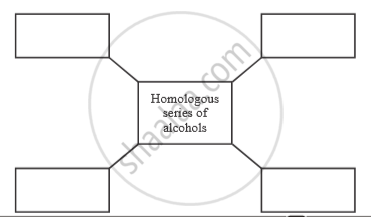Advertisements
Advertisements
प्रश्न
What is a homologous series?
What is a homologous series? Explain with an example.
उत्तर १
Homologous series is a group of organic compounds with a similar structure and similar chemical properties in which the successive compounds differ by a CH2 group.
उत्तर २
A homologous series is a series of carbon compounds that have different numbers of carbon atoms but contain the same functional group.
For example, methane, ethane, propane, butane, etc. are all part of the alkane homologous series. The general formula of this series is CnH2n+2.
Methane CH4
Ethane CH3CH3
Propane CH3CH2CH3
Butane CH3CH2CH2CH3
It can be noticed that there is a difference of -CH2 unit between each successive compound.
APPEARS IN
संबंधित प्रश्न
Write the next homologue of the following: C4H6
What is meant by homologous series of carbon compounds?
Write the molecular formula of first two members of homologous series having functional group – OH
Give the structural formula for 1, 2-dichloroethane
Fill in the following blank with suitable word:
Ethene and ethyne are examples of ..... hydrocarbons.
What is the next higher homologue of methanol (CH3OH)?
What is the difference between two consecutive homologues:
(1) in terms of molecular mass?
(2) in terms of number and kind of atoms per molecule?
Give the molecular formula of one homologue of the following:
C3H6
Write the names and formulae for the first three members of the homologous series for chloroalkanes.
Define a homologous series. Give the name and structural formula of one homologue of the following:
CH3OH
The number of carbon atoms present in the molecule of fifth member of the homologous series of alkynes is:
(a) four
(b) five
(c) six
(d) seven
The molecular formula of the third member of the homologous series of ketones is:
(a) C4H8O
(b) C3H6O
(c) C5H10O
(d) C6H12O
An organic compound having the molecular formula C3H6O can exist in the form of two isomers A and B having different functional groups. The isomer A is a liquid which is used as a solvent for nail polish. The isomer B is also a liquid. An aqueous solution of one of the lower homologues of B is used for preserving biological specimens in the laboratory
(a) What is compound A?
(b) Write the electron-dot structure of A.
(c) What is compound B?
(d) Write the electron-dot structure of B.
(e) Name the lower homologue of compound B which is used in preserving biological specimens.
A colourless organic liquid X of molecular formula C2H4O2 turns blue litmus to red. Another colourless organic liquid Y of molecular formula C3H6O has no action on any litmus but it is used as a nail polish remover. A yet another colourless organic liquid Z of molecular formula C2H6O has also no action on litmus but it is used in tincture of iodine.
(a) Name the liquid X. To which homologous series does it belong? Give the name of another member of this homologous series.
(b) Name the liquid Y. To which homologous series does it belong? Write the name of another member of this homologous series.
(c) Can you name an organic compound having the same molecular formula as liquid Y but which belongs to a different homologous series? What is this homologous series?
(d) Name the liquid Z. To which homologous series does it belong? Write the name of another member of this homologous series.
Propane and ethane are ______.
Give the dot diagram of the first member of the alcohol.
Why homologous series of carbon compounds are so called? Write chemical formula of two consecutive members of a homologous series and state the part of these compounds that determines their (i) physical properties, and (ii) chemical properties.
Write names of first four homologous series of alcohols.

What is a homologous series?
The general formula of Alkane is _________________
Cyclohexane : Cyclic hydrocarbon : : Isobutylene : _______
Which of the following pairs can be the successive members of a homologous series?
Successive members of a homologous series vary by how many atomic mass unit?
The first member of alkyne homologous series is
Define Homologous series.
Write the chemical formula of two consecutive homologous of organic compounds having functional group - OH.
What happens to the (i) boiling point and (ii) solubility of organic compounds of a homologous series as the molecular mass increases?
